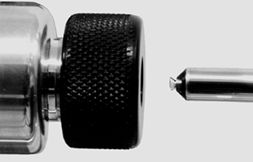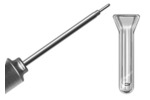- ▶
- Heaters/Source
- ▶
- Agilent Heaters and SensorsMass Spectrometry, Scientific Supplies & ManufacturingScientific Instrument Services 5973 Source Heater Tamper Resistant Allen Wrench 5973/5975 Quad Sensor 5985 Source Heater Assembly Agilent Interface Heater Assembly 5971 Interface Heater

- ▶
- Reference Material on InstrumentationArticle - A High Temperature Direct Probe for a Mass Spectrometer Design of a Direct Exposure Probe and Controller for use ona Hewlett-Packard 5989 Mass Spectrometer SIS AP1000 AutoProbe™ SIS AP2000 AutoProbe™ - Description of System HPP7: Direct Probe Electronics Console HPP7: Direct Probe for the Agilent (HP) 5973/5975 MSD HPP7: HP Direct Probe Application Notes HPP7: Installation Directions for the Direct Probe HPP7: Side Cover for the HP 5973 MSD HPP7: Support HPP7: Probe Inlet System for the Agilent (HP) 5973 and 5975 MSD with Automatic Indexed Stops HPP7: Theory of Operation of the Direct Probe and Probe Inlet System Direct Thermal Extraction Thermal Desorption Application Notes Environmental Thermal Desorption Application Notes Food Science Thermal Desorption Application Notes Forensic Thermal Desorption Application Notes GC Cryo-Trap Application Notes Headspace Application Notes Purge & Trap Thermal Desorption Application Notes Theory of Operation of the AutoDesorb® System AutoDesorb Notes for SIS Dealers Adsorbent Resin Application Notes Installation of the Short Path Thermal Desorption System on Agilent (HP) and Other GCs Installation of the Short Path Thermal Desorption System on a Varian 3400 GC AutoDesorb® System Development Team Thermal Desorption Applications and Reference Materials Installation of the Short Path Thermal Desorption System - TD5 Part I - Design & Operation of the Short Path ThermalDesorption System Installation Instructions for the Model 951 GC Cryo-Trap on the HP 5890 Series GC Installation Instructions for the Model 961 GC Cryo-Trap on the HP 5890 Series GC Operation of the Model 951/961 GC Cryo-Trap SIS GC Cryo Traps - Theory of Operation NIST/EPA/NIH Mass Spectral Enhancements - 1998 version (NIST98) SIMION 3D Ion Optics Class Mass Spectrometer Source Cleaning Methods MS Tip: Mass Spectrometer Source Cleaning Procedures Mass Spec Source Cleaning Procedures Micro-Mesh® Abrasive Sheets Research Papers Using New Era Syringe Pump Systems EI Positive Ion Spectra for Perfluorokerosene (PFK) Cap Liner Information How do I convert between fluid oz and milliliters? Which bottle material should I choose? Which bottle mouth should I choose? The Bottle Selection Guide CGA Connections for Gas Tanks Chemical Reaction Interface Mass Spectrometry (CRIMS)

- Probes
- LiteratureApplication Notes Adsorbent Resins Guide Mass Spec Tips SDS Sheets FAQ MS Calibration Compound Spectra Manuals MS Links/Labs/ Organizations MS Online Tools Flyers on Products/Services Scientific Supplies Catalog About Us NextAdvance Bullet Blender® Homogenizer Protocols Micro-Mesh® Literature Instrumentation Literature Agilent GC/MS Literature SIS News / E-Mail Newsletter NIST MS Database - Update Notifications

- ▶
- HPP7: Direct Probe for the Agilent (HP) 5973/5975 MSD (This Page)

- Probe Rod is 0.25" in Diameter by 6.8" Long
- Temperature Range 25 to 450 Degrees C
- Ballistic Ramp Rate > 500 degrees per minute
- Programmable Ramping up to 400 degrees per minute
- 25 Levels of Ramping
- Flared Glass Sample Vials
- Spring Loaded Sample Vial Holder
- Forced Air Cooling
The SIS probe for the Agilent 5973 or 5975 MSD is only 1/4" in diameter which enables it to easily slide through the probe sealing system and into the MSD. It is light in weight and easily fits into the hand for ease of use. The probe tip with sample vial can be heated up to 450 degrees C either ballistically or with a programmable ramp rate. In the ballistic mode it will ramp up to temperature in excess of 500 degrees per minute or alternatively it can be used in the temperature ramp mode which has 25 levels of ramping capabilities to provide for the ultimate control of probe tip temperature. For cooling the probe, compressed air is used. This permits the cooling of the probe after sample analysis and before the probe is removed from the MSD through the vacuum seals. This prevents damage to the probe vacuum seals.


Probe Tip with Sample Vial Ready for Injection into the MSD
The probe tip incorporates a small spring to gently hold the sample vial in place. The probe is designed for using flared glass sample vials. These flared sample vials permit the efficient introduction of samples (both solid and liquid) into the sample vials and permit the easy insertion and removal of the sample vials from the probe tip without breakage.


